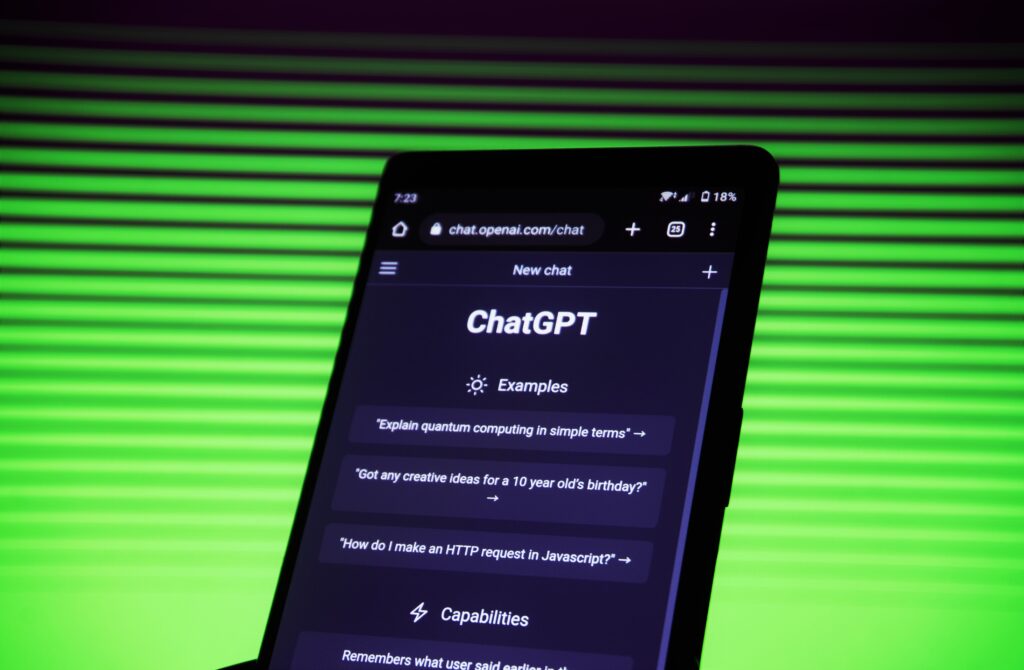GPT chat and the impact on cross-border shipments and returns
The topic of the relevance and applicability of tools related to artificial intelligence (AI), including in the conduct of online business, is being expanded every day with new facts and solutions, created, however, mainly by the person’s mind. The bearishness of the issue may be highlighted by the fact that in early April one of the AI tools – Chat GPT – was banned in Italy. What is this trend, where does the controversy come from, and how can it change everyday life in logistics?

Publication date:
Table of content:
- What is CHAT GPT ? And what is Google Bard ?
- How is AI / artificial intelligence impacting the Internet, ecommerce and logistics now?
- How can AI affect e-commerce and cross-border logistics ?
- How can AI help you with your e-commerce business right now ?
What is CHAT GPT ? And what is Google Bard ?
Chat GPT (Generative Pre-trained Transformer) is an example of one of the absolutely shower technologies that has revolutionized the way Internet users interact. Sometimes referred to as the fifth or the next, by any number, industrial revolution, the communication change that is happening to us is an expression of trust in artificial intelligence and allowing its voice with human hands not only in business, but also in private daily life. Each chatbot is a system using artificial intelligence, which allows bots to communicate with customers in a natural language similar to humans. The most famous one – Chat GPT has hundreds of functionalities and was developed by the Open AI consortium, formed in 2015, initially on a non-profit basis to bring solutions that give measurable benefit to people.

Instead, Google Bard is a solution, let’s say from the beginning, a corporate solution, focused on monetization and designed as a huge ecosystem that, by virtue of its widest availability in the world, is expected to take the lead among artificial intelligence solutions. For the moment it is in the testing phase, made available to a relatively small audience. As far as we know, it is mainly being tested by programmers, so it will be prominent in the development of website and application codes and all sorts of interfaces including logistics. It is supposed to have better abstract thinking capabilities than GPT Chat and better understand mathematics and is expected to cope with more descriptive answers to questions.
All of the available tools we know today were developed based on the principle of machine learning, and learn from the data it is trained on and trained by. This means that the tool has to receive some textual and intellectual input in order to synthesize the data and try to draw conclusions in the form of answers or lines of code. By understanding the context of the conversation, Chatbots can, if they learn effectively, provide not only right, but also helpful answers to questions or requests for help in content generating.
Chat GPT is a tool that creates its knowledge base by managing up to six billion parameters, which it checks in real time and updates (regardless of the officially announced version of the so-called product launch). Google’s Bard combines a maximum of one billion six hundred million parameters during the preparation of results. To visualize the size of the base from which the tools draw, we decided to write them down in words. While the full, paid version of GPT Chat supports and helps check and detect plagiarism in any language (of course, the effectiveness depends on the language used and is greatest in English), Bard does not have this ability.
It’s definitely a point worth mentioning, particular in Europe, that Bard is based on Google’s engine and draws its data, inference and predictions, let’s say even predictions, from that very search engine and analytics, while the GPT chat draws on the knowledge and experience of the Microsoft-affiliated Bing search engine. Interestingly, Microsoft itself, independently of its Open AI product, has been working on an effective version of its solution (Bing AI and Copilot) for quite some time. So the podium in this area seems to have already been occupied in the close horizon.
How is AI / artificial intelligence impacting the Internet, ecommerce and logistics now?
How programs based on the Large Language Model (LLM) work? The concept is potentially simple, but not the easiest to explain. The goal is to replicate and provide answers within a natural, native language framework. In the case of Google Bard, this will be the LaMD language model announced in 2021, and in the case of OpenAI’s product, it’s simply GPT-4. The tools tell us that as AI, they use “a series of autocomplete-like programs to learn the language,” and that the programs attempt to understand “the statistical properties of the language” to “make mature predictive inferences based on the words you typed earlier.”
The point is that when you’re chatting on a company’s Slack, Messenger or even Teams, you won’t recognize or feel the difference between when you’re really talking to a co-worker or colleague and when you’re… talking to a bot. And no, it’s not about some avatars and faces flapping or dropping jokes that we know from “typical chats” on websites and e-commerce sites, asking what they can help us with.

Chat GPT technology today can provide a number of benefits that include improved customer service, reduced operating costs, improved speed and accuracy in the information provided, and increased revenue by optimizing, for example, employment. By automating communication with customers, logistics companies, for example, including parcel operators or carriers more broadly, can provide 24/7 customer service without the need for human interaction. Of course, from a moral or humanitarian point of view, the issue is fundamentally misshapen.
Customers can get answers to their inquiries in real time, and this reduces the waiting time for the first “humanized” contact with the brand, sometimes called the point of endorsement, which significantly affects brand perception.
Speed of response is crucial precisely in e-commerce logistics, where customers like to track their orders, and updating the shipping status is a kind of hobby for some consumers.
See our logistics service solutions: Global24
In terms of speed and real-time acting – and as users see on the screen when AI technology produces text ‘before our eyes’, Chat GPT has the potential to revolutionize data visibility and brand traceability.
It’s not particularly challenging for artificial intelligence through a chatbot to write terms and conditions or product descriptions based on the data provided. At the moment, these descriptions will be unique up to a certain point, once more data is entered (it is not specified), they will start repeating themselves – this is how the algorithm works. Experienced testers report that in the case of graphics, banner creations and logos, the process of uniqueness is longer, so to a greater extent it can fill the creative skills of a human.
How can AI affect e-commerce and cross-border logistics ?
In the changing world of logistics, companies are constantly looking for ways to improve visibility of shipment statuses – this toward “to the customer” and traceability in the supply chain – this toward “to themselves.”
Traditional logistics teams rely on a number of different, not necessarily connected, technology systems. This control and inference is used for planning, inventory tracking and shipment status. In the warehouse, they include physical space management systems, barcode scanners, RFID tags and forecasting software. While these systems effectively supply data, they can be unintuitive and difficult to use, requiring learning how to use them, each and every one. Because they are created by, with and stimulated by humans, they are subject to the natural risk of error for the human mind.
Generative Pre-trained Transformer tools, as opposed to classic systems, can offer a more user-friendly experience. Requiring only one-time training. As warehouse workers, truck drivers and other logisticians go about their daily tasks, they can use the artificial intelligence ecosystem without even knowing it, and the multilingual capability reflected in a statistically natural language will guide them further in multinational communication. Responses to input are already identified as fully natural human.
See what changes have been introduced in Spain in the registration of packaging and waste: Packaging/waste registration in Spain – changes
Utilizing AI for cross-border shipments and returns:
By automating customer service and multilingualism, Artificial Intelligence-based Chatbots can improve the quality and efficiency of customer service in the shipment and returns process, by answering questions quickly and accurately and responding proactively to potential problems, similar to human emotions (of course, the tool must have emotional predicates in mind ahead of time)
Another way in which artificial intelligence can impact the shipping and returns process is through the use of algorithms to analyze and optimize logistics processes. Through data analysis and predictive models, AI can help optimize routes and delivery times, which can help deliver shipments to customers faster and more efficiently. Perhaps in a short time AI itself will be able to determine the gravitational point for a returns hub or count the costs and indicate the savings from changing the location of such a hub – we will immediately check at Global24.
Finally, artificial intelligence technologies can also help combat fraud and fraudulent cross-border transactions. Algorithms can automatically analyze transactions and detect suspicious behavior, allowing for quick response and avoidance of fraud. This includes, for example, criminal buying groups or sending a dubious number of items from a location that is not a legitimate business, etc.
However, it is worth pointing out at the end of this section that the proper operation of the tools is based on the detailed data we enter. That’s why we sometimes get so wrapped up in talking to a chatbot that we provide data that not only in real life, but also in the online life we’ve known so far, we wouldn’t provide. That’s why Italy’s data protection authority has made it illegal to use GPT in that country at the moment because of the gigantic ease of market liquidation of sensitive data. Unbelievable and because of people’s behavior to the chatbot and because of the ban… and yet.
How can AI help you with your e-commerce business right now ?
Order tracking: Chatbots can help customers track their orders in real time. This can be done by integrating GPT with a logistics system that can provide updates on order status, estimated delivery time and other volumetric data.
Personalized recommendations: LLM and GPT can be programmed to provide personalized recommendations to customers based on their browsing and purchase history. This can be helpful in improving sales and increasing shopping cart.
Improving Operations: Chatbots can be used to streamline our day-to-day operations by automating tasks such as order processing, inventory tracking, payments, sales document issuance and ongoing customer service.
Descriptions and graphics, translations, reputation management and user retention – are other areas of usefulness, perhaps deserving a dedicated post.
Today and innovative logistics in partnership with Global24
Logistics issues are evolving as fast as trends in the use of artificial intelligence. Admittedly, we don’t see this progress as quickly and transparently, and no separate tools are being developed with a bang-for-the-buck launch, but as industry professionals, we know about all the news, we follow it, and we look forward to introducing new solutions. If you need a consultation or would simply like to talk about logistics trends and find out where process simplification is going, don’t hesitate to let us know about your needs. After all, according to our mission statement: “We are here to create SOLUTIONS for you and your customers. Always be a STEP ahead.”
Artificial intelligence, Chat GPT and chatbots – surprise
Inspired by the media hype and social media feedback, we decided to try what using GPT chat in logistics is related to. However, we did not choose the topic of shipment logistics, returns or even warehousing for the test. We tested… text logistics. Yes, you expect well, in this post on our blog you will find hidden sentences written by GPT chat. You might find them, you might not, because we take care of our unique text communication. However, if you would like to find them, we hint that there are three sentences, and the chatbot answered questions asked in Polish, German and English. Without a doubt, it is useful for both e-commerce and content publishing, as demonstrated in this article.
Do you want to be up to date?
Subscribe to the newsletter
Subscribe to the CROSS-BORDER LETTER newsletter! Learn about news, tricks and secrets in foreign logistics. Check how to sell abroad and achieve more benefits.





